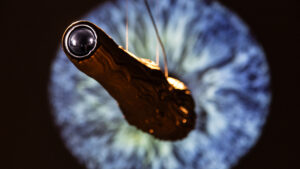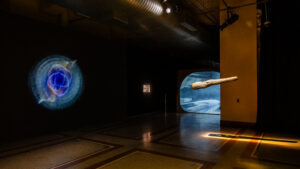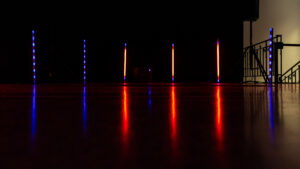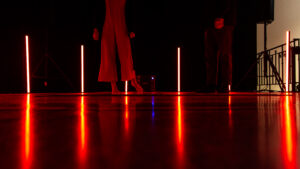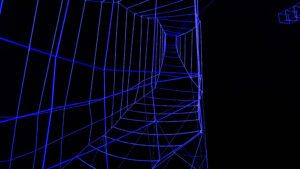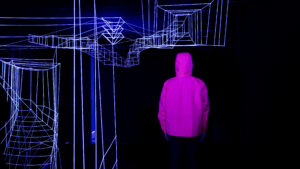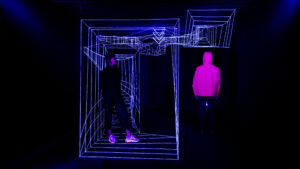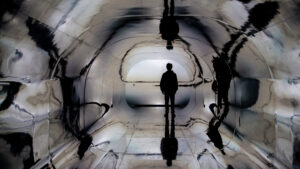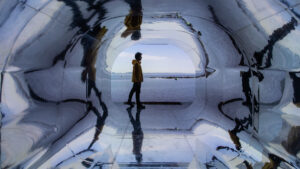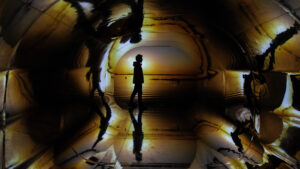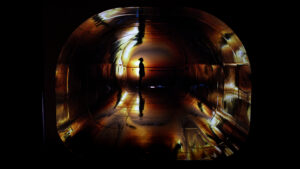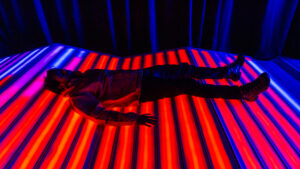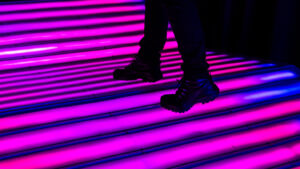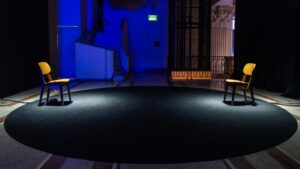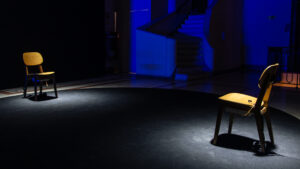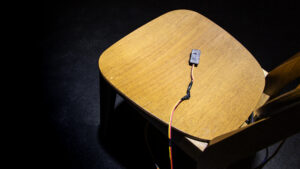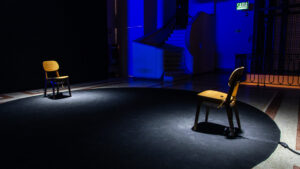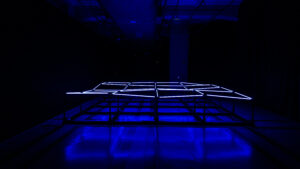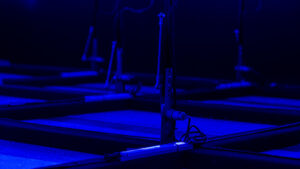SMART LIGHTS – LUZES INTELIGENTES (PORTO ALEGRE, BRAZIL)
Held on the second floor of Farol Santander Porto Alegre from July 19 to September 24, 2023, Smart Lights – Intelligent Lights brought together works by renowned Brazilian artists Anaisa Franco, Gisele Motta and Leandro Lima, Guto Requena, Modular Dreams, Rejane Cantoni, and Sabrina Barrios. The exhibition is an immersion in the fascinating world of light art, featuring works that have already circulated in the art circuit and that use light as the primary source of their poetic activations, whether through interactivity, site-specific approaches, or immersion.
There were seven works in total, each with its unique approach: the immersive site-specific work by Sabrina Barrios, which used light as spatial matter to create a luminescent weave that alludes to the metaverse; the autonomous sculpture Zero Hidrográfico by Motta & Lima, a robotic dance of light and color evoking the movement of waves; the robust yet delicate work Periscópio by Rejane Cantoni, which offered a contemplative immersion in homage to the stunning sunset over the Guaíba River. Completing the exhibition were works that are true interactive experiences: Dreamdeck by the duo Modular Dreams, Banco das Emoções by Estúdio Guto Requena, and Expanded Iris and Love Synthesizer by Anaisa Franco.
In common, these works invited the public to participate in a playful universe where the exchange of experiences and the sharing of emotions are part of the sensory experience.
Smart Lights – Intelligent Lights is a production of the Ministry of Culture through the Cultural Incentive Law, with sponsorship from Santander Brasil and partnership with Holly Cow.
OBRAS / ARTISTAS
Expanded Iris, 2022 - Anaisa Franco Studio
customized software, computer, iriscope camera, 3-D-printed telescope, speakers, and a projector
Interactive installation that scans the user’s iris and merges it with galaxies and nebulae through custom software and a 3-D-printed telescope formed by elongating the artist’s iris scan.
Anaisa Franco (Uberlândia, MG)
Anaisa Franco (Uberlândia, MG, Brazil, 1981) creates affective sculptural works to activate the body and public space through a playful and interactive approach. The artist uses parametric design and digital fabrication integrated with technology to connect physical structural elements with digital expressions using lights, sensors, and new materials. Her pieces reflect the round and curved forms found at molecular and macro levels, connecting and reshaping the way we see the world. Franco holds a master’s degree in advanced architecture from IAAC, Barcelona, Spain, a year of M-Arch 1 at SCI-Arc, Los Angeles, USA, as well as a master’s degree in digital art and technology from the University of Plymouth, England, and a bachelor’s degree in visual arts from FAAP, São Paulo. Her artworks have been presented in various countries such as the United States, Ireland, Australia, France, Germany, Spain, the Netherlands, Switzerland, China, South Korea, and Brazil.
Love Synthesizer, 2020 - Anaisa Franco Studio
LEDs, computer, Playtronic, speakers, touch sensor
Immersive audiovisual instrument that synthesizes sounds and lights through the touch of the skin between two or more people. The artwork creates an interactive orchestra that responds to human contact, fostering a magical connection among individuals within an immersive musical instrument.
Anaisa Franco (Uberlândia, MG)
Anaisa Franco (Uberlândia, MG, Brazil, 1981) creates affective sculptural works to activate the body and public space through a playful and interactive approach. The artist uses parametric design and digital fabrication integrated with technology to connect physical structural elements with digital expressions using lights, sensors, and new materials. Her pieces reflect the round and curved forms found at molecular and macro levels, connecting and reshaping the way we see the world. Franco holds a master’s degree in advanced architecture from IAAC, Barcelona, Spain, a year of M-Arch 1 at SCI-Arc, Los Angeles, USA, as well as a master’s degree in digital art and technology from the University of Plymouth, England, and a bachelor’s degree in visual arts from FAAP, São Paulo. Her artworks have been presented in various countries such as the United States, Ireland, Australia, France, Germany, Spain, the Netherlands, Switzerland, China, South Korea, and Brazil.
Corrente, 2023 - Sabrina Barrios
white strings, fishing wire, UV light
Site-specific installation that uses light, symbols, and repetition to create an atmosphere that evokes a parallel dimension, a portal between the physical and virtual space. Visually, the artwork alludes to holograms, metaverse, and other dimensions, exploring possibilities of alternative realities. Simultaneously, it seeks to reconnect with the essence through the simplification of forms, colors, and sacred geometry.
Sabrina Barrios (Santa Maria, RS, Brazil)
Sabrina Barrios (Santa Maria, Brazil, 1981) worked as a designer in São Paulo, London, and Berlin before moving to New York in 2009 to complete her master’s degree at the Pratt Institute (New York, USA, 2012). Her recent exhibitions include immersive experiences worldwide, such as HoloDeity (Illumination, New York, USA, 2023); Estação Portal (MACS – Museum of Contemporary Art of Sorocaba, São Paulo, Brazil, 2022); Rise of the Missing Planet (NOoSphere Arts, New York, USA, 2022); Frequência do Invisível (MASM – Museum of Art of Santa Maria, Rio Grande do Sul, Brazil, 2019); Feixe (Casa Amarela, São Paulo, Brazil, 2018); Epic of Creation (Arteles, Haukijärvi, Finland, 2017); The Earth Experiment (No4 Studio) and Ley Lines (Wassaic Project), both in New York, USA, 2017; Coup d’Etat (Staten Island Cultural Center, New York, USA) and The Horse Rider and The Eagle (Bains Connective, Brussels, Belgium), both in 2016; Atlantis (Aabenraa Biennial for Contemporary Art, Denmark) in 2015; Orion and Vega (Dumbo Arts Festival, New York, USA, 2014); Degrees of Freedom (Harlem Art Factory Fest, New York, USA, 2013). Sabrina exhibited her paintings at the JustMAD Art Fair (Madrid, Spain, 2016) and Anita Schwartz Gallery (Rio de Janeiro, Brazil, 2014 and 2015); her videos at Bienal desde Aquí (Barranquilla, Colombia, 2015) and MoMA: Abstract Currents (Museum of Modern Art, New York, USA, 2013). Her residencies/grants include The Studios at MASS MoCA (Massachusetts, USA, 2017); Arteles (Haukijärvi, Finland, 2017); The Bronx Museum-AIM Program (New York, USA, 2016); Just Residence-Fundação Banco Santander (Málaga-Madrid, Spain, 2016); Bains Connective (Brussels, Belgium, 2016); and The Wassaic Project (New York, USA, 2015). Sabrina’s work was included in the Fourth Bronx Museum Biennial in New York (2017) and the Baku Biennial in Azerbaijan (2019). She currently lives between New York and Rio de Janeiro, creating participatory and multimedia art.
Periscópio, 2023 - Rejane Cantoni
cylindrical wooden modules, metalized PETG, rear-projection screen, and projector
Site-specific sculpture measuring ten meters in length, designed to engage the visitor in a landscape. At one end of the cylinder, a projection screen displays the horizon of Porto Alegre at different times and weather conditions, transporting you into a unique visual experience.
Rejane Cantoni (São Paulo, SP)
Rejane Cantoni (São Paulo, Brazil, 1959) is an artist who works with interactive installations and site-specific projects on a large scale. Invited by institutions to create artworks in various cities around the world, she develops innovative installations that offer visceral mediations on how individuals perceive and communicate in the spaces they inhabit. She has exhibited at Ars Electronica (Linz, Austria; Berlin, Germany; Mexico City, Mexico), The Creators Project (New York, USA; São Paulo, Brazil), ZKM | Media Museum (Karlsruhe, Germany), Glow and STRP Festivals (Eindhoven, Netherlands), Moscow Biennale of Contemporary Art (Moscow, Russia), Espacio Fundación Telefónica (Buenos Aires, Argentina), Copenhagen Contemporary Art Festival (Denmark), FILE – International Festival of Electronic Language (São Paulo, Rio de Janeiro, Curitiba, Porto Alegre), Synthetic Times – Media Art China 2008 (Beijing, China), Zeebrastraat (Ghent, Belgium), Mois Multi (Quebec, Canada), Thingworld – International Triennial of New Media Art 2014 (Beijing, China), Ruhrtriennale 2014 (Duisburg, Germany), Asia Culture Center/ACC (Gwangju, South Korea), Wonderspaces (San Diego and Scottsdale, USA), Wavelength (Shenzhen, Shanghai, Beijing [China]), Floras (São Paulo, Rio de Janeiro; Bogotá, Colombia; Lisbon, Portugal; Web3). Rejane holds a post-doctorate in arts, a PhD and master’s degree in communication and semiotics, and a master’s degree in Information Technology Studies from the University of Geneva, Switzerland. Before becoming an independent artist, she was the vice-director and professor at the Faculty of Mathematics, Physics, and Technology at the Pontifical Catholic University of São Paulo (PUC). She is a member of the Interplanetary Initiative at Arizona State University, USA.
Dreamdeck, 2019 - Modular Dreams
metal structure, acrylic, PS, EVA, addressable LED, weight sensors, and Arduino
Interactive electronic toy for all ages that also doubles as furniture. The movement and weight of your own body as you climb onto the interactive relief installed on the floor trigger the shimmering video images that illuminate the LED mesh beneath the artwork.
Modular Dreams (São Paulo, SP, Brazil)
Created by artists Danilo Barros and Priscilla Cesarino (both born in São Paulo, Brazil, in 1980 and 1979, respectively), the Modular Dreams studio explores art in an expanded and immersive way. Its main elements of language are movement and light, always tied together by conceptual and aesthetic coherence. Its vision and intent are increasingly focused on blurring the boundaries between art and life through their actions and creations. With this mission, and grounded in visual art, their works take on various forms such as music videos, mapped projections, interactive LED art scenography, audiovisual performances, site-specific installations, and printed art in various sizes and formats. Modular Dreams is among the most relevant and active artists in São Paulo’s electronic cultural scene, helping shape and conceptualize it since its early revolutions in the capital. They are particularly known for their residency at the Capslock party, numerous interventions at ODD, and significant participation in the Dutch festival DGTL (where they were responsible for an entire stage and performed for over 10,000 people, receiving an excellent response from the audience and festival organizers). The studio also stands out for having undertaken numerous projects for important brands such as Natura, Rock in Rio, Netflix, Santander, Itaú Cultural, Museu da Imigração, Pixel Show, Red Bull, TNT, Casa de Criadores, T-Jamas, Santista Têxtil, O2 Produções, Agência Bullet, and many others.
Banco das Emoções, 2019 - 2023 - Estúdio Guto Requena
wooden chairs, heart-rate sensors, microcomputers, bass shakers, and LED spotlights
Interactive furniture where participants can sit and feel each other’s heartbeat in real time. With specially positioned sensors, the heart rate is transmitted through luminous effects and vibrations applied to the wooden structure of the seat, in synchrony with the lighting.
Guto Requena (Sorocaba, SP, Brazil)
Guto Requena (Sorocaba, SP, Brazil, 1979) graduated in architecture and urbanism in 2003 from the University of São Paulo. For nine years, he was a researcher at NOMADS.USP (University of São Paulo’s Center for the Study of Interactive Habitats). In 2007, he obtained his master’s degree from the same university with the dissertation “Hybrid Habitation: Interactivity and Experience in the Cyberculture Era.” In 2008, Requena founded Estudio Guto Requena. He has received numerous awards, given lectures, and exhibited in more than twenty countries ever since. Between 2012 and 2015, Requena was a columnist for design, architecture, and urbanism in the Folha de S.Paulo newspaper, as well as collaborating with various magazines. Since 2011, Guto has been creating, scripting, and presenting series for TV, the web, and cinema.
ESTUDIO GUTO REQUENA
Estudio Guto Requena reflects on memory, culture, and narrative poetics in different design scales, such as objects, spaces, and cities. The studio is divided into four project nuclei: Architecture Nucleus, where they create interiors, scenographies, and buildings; Product Nucleus, where they design objects and furniture; Communication and Media Nucleus, developing programs for TV and the web, consultations, books, lectures, and events; and finally, the Juntxs Nucleus – Laboratory for Empathy, Design, and Technology Studies, where they conceive immersive installations and interactive experiences. What connects all the projects of Estudio Guto Requena is their desire to investigate design and digital technologies in an emotional way to stimulate empathy and collectivity. Their great passion lies in hybridizing the analog with the virtual.
Zero Hidrográfico, 2010 - Motta&Lima
40 T5 tube lamps, 25 motorized mechanisms of variable sizes
Kinetic installation composed of lamps and a motorized system to create a suspended luminous plane that emulates the movement of ocean waves’ surface. Zero Hidrográfico (Chart Datum) is the reference altitude used to measure ocean depths, and its waters tend to rise due to global warming.
Motta&Lima (São Paulo, SP)
The partnership between Gisela Motta and Leandro Lima (both born in São Paulo, Brazil, in 1976) began in the late 1990s. Since then, the duo’s work has been presented in exhibitions such as Yano-a (Claudia Andujar Gallery, Inhotim Institute, Brumadinho, MG); Constructions and Geometries (Brazilian Museum of Sculpture, São Paulo); Amazonia. The Shaman and Mind of the Forest (Museum of History, Nantes, France), all in 2019; Entreter (Farol Santander, São Paulo) and Confused Public and Private (Third Beijing Photo Biennial, China), both in 2018; Guangzhou Image Triennial (Guangdong Museum of Art, China), in 2017, among others. Their work is part of collections such as the CIFO Art Foundation Collection (Miami, USA); Figueiredo Ferraz Institute (Ribeirão Preto, SP); Itaú Cultural Institute (São Paulo); and Pinacoteca Collection of São Paulo.
